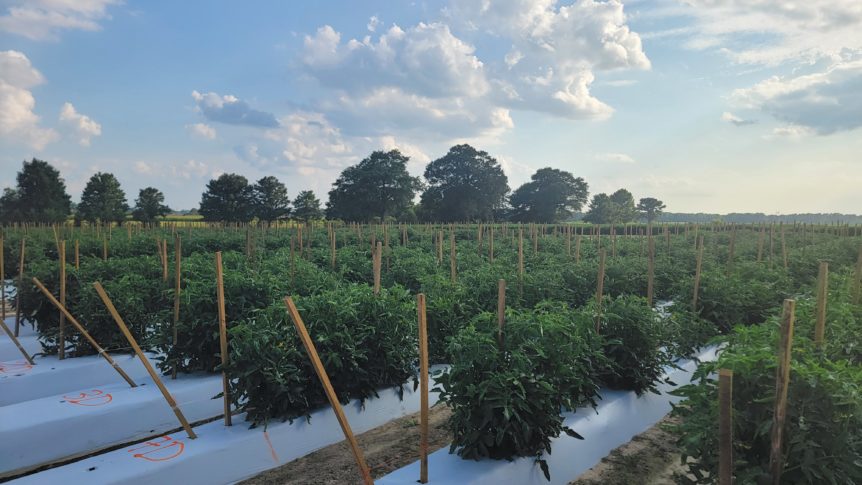
By Frank Giles
Southeastern tomato growers largely rely on plasticulture to produce commercial-scale crops. Production practices are well established, but some growers are considering new bed designs based upon recent research.
Sanjay Shukla, University of Florida Institute of Food and Agricultural Sciences (UF/IFAS) professor of water quality, initiated research several years ago to examine potential benefits of a new bed architecture that is narrower and taller than the traditional bed design. The concept is called the compact bed. In Florida, some growers have adopted the practice.
The UF/IFAS research has sparked interest in other parts of the Southeast. Emmanuel Torres Quezada, assistant professor of horticulture at North Carolina State University, initiated trials to learn how compact beds would work for the state’s tomato growers. This research was supported by funding from the National Institute of Food and Agriculture.
“Since Dr. Shukla did his study, the use of compact beds has been moving north, especially on the East Coast,” Quezada said. “So, we wanted to look at this here in North Carolina. These are tall and narrow beds. We are taking the width to 18 inches vs. 24 inches and increasing the height from 8 inches all the way to 12 inches. The premise is by narrowing the width and increasing the height, the distribution of the water is better because you have your drip tape right in the middle and it’s going to be closer to the shoulder of the bed.
“If you have a sandy soil like we have here in North Carolina and a traditional bed that is 24 inches wide, that water will have to move laterally all the way to the shoulder, and sometimes that doesn’t happen.”
Fumigation Trial
In addition to better water distribution, Quezada wanted to see if the compact design might also help improve the effectiveness of fumigation to control nematodes and weeds. Fumigation is a critical step in productive plasticulture systems.
Quezada developed his trial to test how a commonly used fumigant preformed in traditional beds vs. compact beds. He used Pic-Clor 60. The product was compared against a no-treatment control versus a shank application, drip application and drip plus soil surfactant application. Quezada compared the control of nematodes and weeds in traditional and compact beds.
He ran the trial on white and reflective mulches because more growers in the Southeast are moving to those away from black plastic. In previous research, Quezada demonstrated white and reflective mulches produce higher tomato yields than black plastic.
“Farmers in the east are moving to white and reflective away from the black largely because of the soil temperatures, unless we had a really cold year, or they are planting extremely early. In one study, temperatures topped 120 degrees under black plastic. That was compared to white and reflective mulches, where temperatures were closer to 100 degrees. Those 20 degrees create a difference in yields. We are talking almost 5 tons more tomatoes compared to the black mulch.”
After running his trial, Quezada reported that the performance of Pic-Clor 60 in controlling nematodes and weeds was not significantly different whether applied to a traditional bed or a compact bed. That was true of all applications — shank, drip and drip plus soil surfactant. In addition, yields were not significantly different. The trial also demonstrated that a soil surfactant was not necessary to improve performance of soil fumigants applied at standard rates.
Upping Density
Another reason compact bed design has captured the interest of growers is that it can allow high density of tomato planting (see Table 1). The design allows for more beds to be squeezed into an acre.
“There is the potential to get 11% more plants per acre with the compact bed architecture,” Quezada said. “The only issue is we need a three-row or six-row bedder that can halve the distance between the planting rows. We are trying to secure funding this year for the bedder so we can do the testing. I don’t see any reason we should not expect an increase in yields because we are adding more plants per acre, and we’ve not seen problems with competition for light in previous research.”










